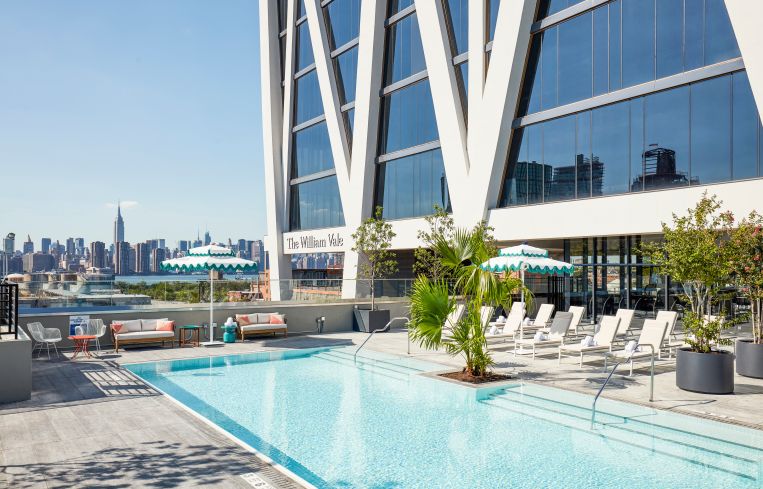After Tepid Growth, Brooklyn Hotel Room Rates Spike
By Lauren Elkies Schram December 21, 2017 4:10 pm
reprints
The Manhattan hotel market—one of the priciest hospitality markets in the country—has been strong this year with hoteliers selling almost nine out of 10 rooms nightly for the first 11 months of this year. But that demand has not amounted to an increase in average daily rates, or ADR, according to new research from STR, a hotel data and analytics specialist.
Manhattan hoteliers have cut nightly room rates this year by 1.6 percent from 2016, to $269.45 (although the room rate is still higher than in any of the 25 largest markets in the U.S. tracked by STR). That is a continuation of the decline in room rates since 2014’s high of $292.46.
In nearby Brooklyn, however, room rates shot up a considerable 4.1 percent to $182.13 year-over-year, as supply surged 21.1 percent, occupancy rose 4.2 percent to 81.5 percent and the number of hotels rose from 61 to 71 today.
Manhattan “is getting very expensive with ADR and development costs and I think a lot of people are looking outside, right across the river,” said Jan Freitag, a senior vice president of lodging insights for STR. “There is very, very strong supply growth and even stronger demand.”
Brooklyn’s 4.1 percent ADR uptick is double the U.S. average percent change to date, and the year-over-year increase is much greater than the borough has seen over the last couple of years. Between 2015 and 2016, the ADR grew by 1.4 percent, and the year prior, it increased 1.3 percent.
Today, Brooklyn hoteliers have more “conviction” to increase their pricing, Freitag said. Brooklyn is now a destination in its own right, and between its proximity to Manhattan and its new product—with sweet amenities—hoteliers have reasons to justify higher prices. To stay at the William Vale Hotel in Williamsburg for one night in mid-January, for example, costs $279 plus taxes, the hotel website indicates.
“Brooklyn is super hot,” Freitag said. “Developers like it. Travelers like it. It has a great reputation, and it’s very close to Manhattan.”
As perceptions about Queens and the Bronx have shifted, their room rates have climbed. In Queens, the ADR rose by 5.1 percent to $157.59 and in the Bronx it went up 4.7 percent to $157.19, STR data covering the first 11 months of the year indicate. The borough’s hotel count increased from 113 last November to 122 today, supply increased 7 percent and occupancy crept up 1.3 percent to 85.5 percent. Hotel room supply in the Bronx jumped 9.2 percent, the number of hotels increased from 22 to 24 today and occupancy ticked up .3 percent to 72.6 percent. (In Staten Island, where the number of hotels remained the same at nine and supply and demand remained flat, the ADR dropped .5 percent to $126.67.)
If the number of rooms sold in Manhattan has increased 3.7 percent for the first 11 months of 2017 from the same period last year and the number of hotels rose from 416 last November to 428 today, why isn’t pricing following suit?
“That’s the billion-dollar question,” Freitag said.
He offered five potential reasons but noted, “The truth is somewhere in the middle”: 1) With so much supply coming online (up 2.7 percent from 2016 at the same point), hoteliers don’t feel comfortable being aggressive in their pricing; 2) the ADR is already high, and the average guest doesn’t want to pay beyond that; 3) new entrants aren’t pricing as strong because they want to achieve occupancy, in turn dragging down the overall market prices; 4) more limited-service hotels are being built, which brings down the price point; and 5) hoteliers focus on hitting 95 percent occupancy, which allows them to get reimbursed by the brand at the ADR rather than a low fixed rate when guests pay for rooms with loyalty points.
As in Manhattan, citywide occupancy has risen this year, but pricing hasn’t follow suit. Through November, New York City hotels saw an 86.5 percent occupancy rate, up 1.1 percent from the same period last year, according to STR figures. ADR was $251, down 1.4 percent year-over-year. And the number of rooms under construction in New York City dipped by 2,000 rooms to 12,000 less than last year at the same time, but that is not anything to be worried about, Freitag said.
The Big Apple’s pipeline is “the highest of any market in the U.S,” he said. “The number we tracked a year ago was a high-water mark for rooms under construction in any market that we track since 1990.”


